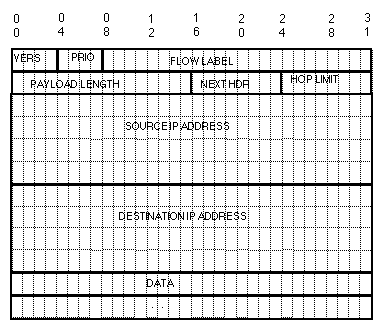|
Header Format

Version: 4-bit IP version number = 6
Prior: 4-bit Priority value. It enables a source
to identify the desired delivery priority of its packets, relative to
other packets from the same source. Values 0-7 are used to
specify the priority of traffic for which the source is providing
congestion control, such as TCP traffic. Values 8-15 are used to
specify the priority of traffic that does not back off in response to
congestion.
0 Uncharacterized traffic
1
" Filter" traffic
2 Unattended data
transfer (e.g., email)
3 (Reserved)
4
Attended bulk
transfer (e.g., FTP, HTTP, NFS)
5 (Reserved)
6
Interactive
traffic (e.g., telnet, X)
7 Internet control
traffic (e.g., routing protocols, SNMP)
8 - 15 ranges from sender's willingness
to discard the packets to the
least willing to
have discarded
the packets. Flow Label:
24 bit field. It is used to give packets some special type of
traffic, such as video messages. One host negotiates with a
router with RSVP-protocol and assigns some amount of capability to
that special traffic. Further explored under the Quality of
Service Capabilities.
Payload Length: 16-bit unsigned
integer. Length of payload, i.e., the rest of the packet
following the IPv6 header, in octets.
Next Hdr: 8-bit selector.
Identifies the type of header immediately following the IPv6
header. Uses the same values as the IPv4 Protocol field.
Hop Limit: 8-bit unsigned
integer. Decremented by 1 by each node that forwards the
packet. The packet will be discarded if Hop Limit is decremented
to zero. In Ipv4, contained time-to-live in seconds.
(seconds are inefficient in that the packet is in a router
approximately every millisecond.)
Source Address: 128 bits.
The address of the initial sender of the packet.
Destination Address: 128
bits. The address of the intended recipient of the packet. |
Header Extension
| Extension name |
What it does |
| Routing |
Extended routing (like IP4 source route)
|
| Fragmentation |
Fragmentation and reassembly |
| Authentication |
Integrity and authentication |
| Security encapsulation |
Confidentiality |
| Hop-by-Hop Option |
Special options which requires processing at
every node |
| Destination options |
Optional information to be examined by
destination node only |
IPv6 contains an improved option mechanism that are
place n separate extension headers that are located between the IPv6
header and the transport-layer header in a packet. 2 major
improvements over IPv4 are: 1. Most of the
extension headers are not examined or processed by any router along a
packet's delivery path until it arrives at its final destination.
The process improves router performance for packets containing
options. 2. The extension headers can be of
arbitrary length and the total amount of options carried in a packet
is not limited to 40 bytes.
The IPv6 options can be used for functions such as
IPv6 Authentication and Security Encapsulation. |